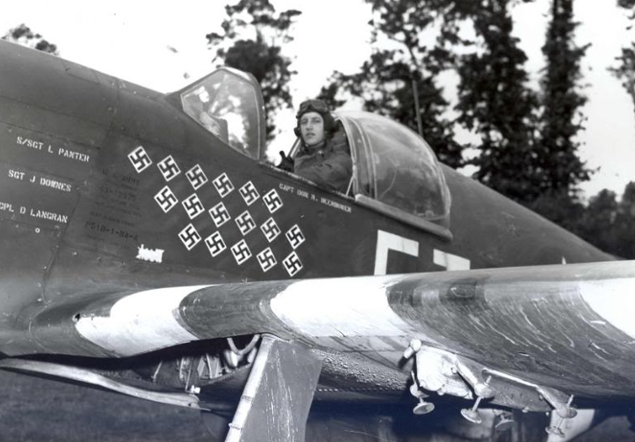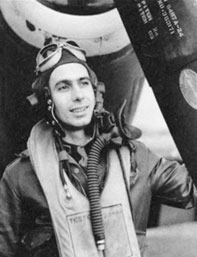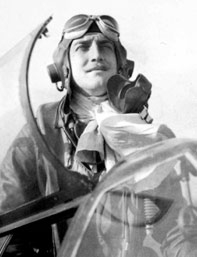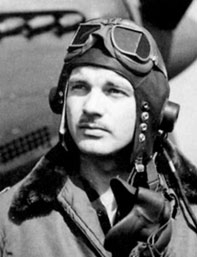Move to France
By 1st Lt. Albert J. Feigen and 1st Lt. Charles F. Kennaw
On the third mission in April, the squadron returned to happy hunting grounds around Brunswick for a penetration support show. In the midst of the four-hour long mission, the bomber box to which our squadron was assigned was tapped by 75 plus enemy aircraft, giving the boys an opportunity of bringing back a large collection of assorted scalps. From this encounter the squadron claimed 12 enemy planes destroyed, 1 probably destroyed and 9 damaged.
By June 30, 1944 all personnel had been moved to Strip A-2, near Cricqueville, France. The squadron flew 33 dive-bombing missions to reach a new high. Rapidly the squadron was reaching its place in the sun, consistently out-flying the enemy over his own soil. An outstanding mission was accomplished on July 26 when Squadron Leader Emmer led a fighter sweep to the St. Lo area. They attacked 40 plus ME109s, odds five to one, spearheaded an intercepting maneuver to prevent them from reaching the clouds. They destroyed 8 enemy aircraft with no losses. For his leadership in this encounter, Captain Emmer was awarded the DSC.

Capt. Don M. Beerbower and his P-51B Mustang "Bonnie B II" displays an impressive scoreboard. On 30 June, Beerbower became the squadron's new C.O. when Maj. Bradley became tour-expired and went home on a 30-day leave. Now Maj. Beerbower led the squadron on a mission to attack the Reims/Champagne airfield on 9 August 1944. Attacking from east to west as a diversion to draw flak from the other flight attacking from north to south, his aircraft took fatal hits from flak guns. Having difficulties getting out he managed to get out of his stricken plane. Maj. Beerbower was too close to the ground for his chute to open. He was the Ninth Air Force leading ace with 15 1/2 confirmed air victories. (National Archives)
From landing strip 31, at Gael, another memorable mission was accomplished on September 12th, when Capt. Charles E. Brown led 16 ships on a fighter sweep in the Frankfurt area. After strafing an airdrome near Limburg, destroying 7 JU-88s and a FW-190 parked about the field they attacked a formation of 40 plus FW-190s just north of Frankfurt. These enemy aircraft were supported by 20 plus ME-190s flying top cover. Our ships returned from this mission in elements of two, some landing at other fields. The final score was 32 aircraft destroyed, 8 of which were on the ground.
A quick summary of the squadron's achievements on October 21, 1944, just one year since embarking for the ETO, show that the outfit's total claims against the enemy were: 239 enemy aircraft destroyed, 14 probable and 106 damaged. Add to this untold and incalculable numbers of enemy material on the ground and it substantiates the faith in the squadron by high army officials. The ratio between our aircraft shot down and Jerries was ten to one. It was during the month of October that Lt. Colonel Jack T. Bradley moved up to Group; Captain Glenn T. Eagleston taking up his duties as Squadron Commander, while Captain James B. Dalglish became Operations Officer.
Losing Our Mustangs
Just before moving from the dark pungent mud of A-66 to the lighter variety at A-98, the 353rd lost its Mustangs and was assigned its first Thunderbolts. It was with sad hearts, that the men parted from the slim, sleek Mustangs, bearing the proud names of "My Buddy"...... "Margie Maru", "Angel's Playmate", and "Bonnie B", which meant something all the way to Kiel and Berlin, and even Poland.
The end of it was that a combat mission took off, found some Jerries and shot down nine of them. To the squadron there was nothing unusual about that but TAC clapped its hands with delight-no Thunderbolt Squadron had ever reached that score before.
The 353rd Fighter Squadron came to a new beginning, a new year with their squadron letters "FT" painted on the bulging sides of the Republic work horses. Pilots made transition flights and ground crews toyed with their new engines, while technical talk flew around the area concerning power checks and water injection. The end of it was that a combat mission took off, found some Jerries and shot down nine of them. To the squadron there was nothing unusual about that but TAC clapped its hands with delight-no Thunderbolt Squadron had ever reached that score before.
Captain Kenneth H. Dahlberg established a unique record in that he destroyed four enemy aircraft in the air twice, on successive missions. Before he was lost as Prisoner of War near Meckel, he had destroyed 15 enemy aircraft in aerial combat, had received the Air Medal with 15 Oak Leaf Clusters, the DFC with one cluster, the Silver Star, as well as the Purple Heart.
Best news of the year came in the announcement of the return of the Mustangs to the Group. They were ferried in from England, 36 of them, circling the field before making a series of low passes, flying in flights abreast over the squadron areas and down the runways. After an intensive week of shakedown inspections and test hops, the Mustangs got off the bumpy runway in less than eight minutes on their first mission.
An Unforgettable Weather Reconnaissance Mission
Lts. Andrew J. Ritchey and Cary W. Salter participated in a more than routine weather reconnaissance. On April 2, 1945 they observed two FW-190s preparing to land at an airdrome near Erfurt, which they destroyed. Continuing on their original mission they shot down other FW-190s with belly tanks (90 plus estimated), evidently intent on bombing the roads and bridges which were jammed with Allied traffic moving in pursuit of the Jerry. They fearlessly bounced the leading elements causing them to scatter. They had to break off their attack because of fuel shortage, but not before they had vectored other groups to the vicinity. Their total claims amounted to three FW-190s destroyed by Lt. Ritchey and one FW-190, one ME-109 destroyed and another FW-190 damaged by Lt. Salter.
In succeeding missions from advanced bases in Germany, the squadron continued to add to their reputation as the leading fighter squadron in the ETO, terminating the war with a box score as follows: 400 E/A destroyed, 16 probable and 162 E/A damaged. The Squadron has produced some 20 Aces, and shares proudly its Distinguished Unit Citation and Cluster thereto with the rest of the Pioneer Mustang Group.



